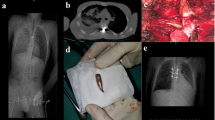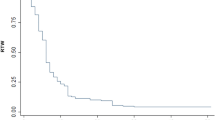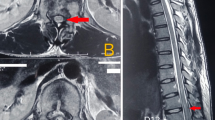Abstract
In order to assess some of the variables associated with neurological recovery after traumatic spinal cord injury with vertebral fracture, a randomised sample of 100 patients (50 without neurological recovery, and 50 with several degrees of recovery) were selected out of 245 patients admitted to our hospital. Both groups were homogeneous with respect to time lapse to admission, hospitalization time and level of lesion. Of the variables considered, the intensity of the lesion (incomplete) and vertebral displacement (under 30%) were statistically associated with neurological recovery. An age under 30 years at the moment of the injury was also associated with neurological recovery but only in those patients with an incomplete lesion. No correlation was found between the other variables studied such as the degree of vertebral wedging, type of fracture (compression, flexion-rotation) and management (conservative, surgical) and the neurological evolution.
Similar content being viewed by others
Log in or create a free account to read this content
Gain free access to this article, as well as selected content from this journal and more on nature.com
or
References
Holdsworth F W . Fractures, dislocations and fractures-dislocations of the spine. J Bone Joint Surg 1963: 45B: 6–20.
Frankel H L, Hancock D O, Hislop G, Melzak J, Michaelis L S, Ungar G H et al. The value of postural reduction in the initial manafement of closed injuries of the spine with paraplegia and tetraplegia. Part I. Paraplegia 1969; 7: 179–192.
Guttmann L . Tratamiento de las fracturas de la columna. Lesiones Medulares. Tratamiento Global e Investigación. 1981; Jims, Barcelona: 141–180.
Schlesselman J J . Case-Control Studies. 1982; Oxford University Press, New York: 194–206.
Burke D C, Murray D D . The management of thoracic and thoracolumbar injuries of the spine with neurological involvement. J Bone Joint Surg 1976: 58B: 72–78.
Davies W E, Morris J J, Hill V . An analysis of conservative (non surgical) management of thoracolumbar fractures and fracture-dislocations with neuronal damage. J Bone Joint Surg 1980: 62A: 1324–1328.
Biering-Sorensen F, Pedersen V, Clausen S . Epidemiology of spinal cord lesions in Denmark. Paraplegia 1990; 28: 105–118.
Dickson J H, Harrington P R, Erwin W D . Results of reduction and stabilization of the severely fractured thoracic and lumbar spine. J Bone Joint Surg 1978: 60A: 799–805.
Young J S, Dexter W R . Neurological recovery distal to the zone of injury in 172 cases of close traumatic spinal cord injury. Paraplegia 1978; 16: 39–49.
Harris P, Karmi M Z, McClemont E, Matlhoko D, Paul S . The prognosis of patients sustaining severe cervical spine injury (C2-C7 inclusive). Paraplegia 1980; 18: 324–330.
Dickson R A . Spinal injuries: early surgical treatment. Paraplegia 1992; 30: 43–45.
Carl-Axel C, Pelletieri L . Treatment of spinal cord injuries in the thoracolumbar region. Scand J Rehab Med 1987; 19: 71–75.
Osebold W R, Weinstein S L, Sprague B L . Thoracolumbar spine fractures. Results of treatment. Spine 1981; 6: 13–34.
Bravo P, Labarta C, Alcaraz M A, Mendoza J . Verdú A. Outcome after vertebral fractures with neurological lesion treated either surgically or conservatively in Spain. Paraplegia 1993; 31: 358–366.
Brown D J . Spinal cord injuries: the last decade and the next. Paraplegia 1992; 30: 77–82.
Bedbrook G M . Spinal injuries with tetraplegia and paraplegia. J Bone Joint Surg 1979: 61B: 267–284.
Author information
Authors and Affiliations
Rights and permissions
About this article
Cite this article
Bravo, P., Labarta, C., Alcaraz, M. et al. An assessment of factors affecting neurological recovery after spinal cord injury with vertebral fracture. Spinal Cord 34, 164–166 (1996). https://doi.org/10.1038/sc.1996.29
Issue date:
DOI: https://doi.org/10.1038/sc.1996.29



